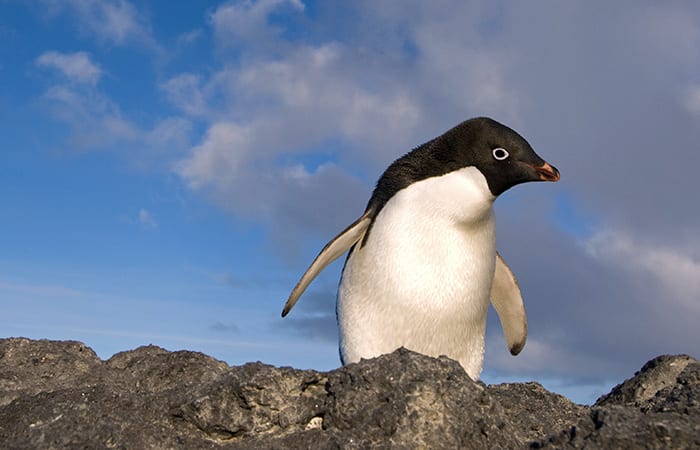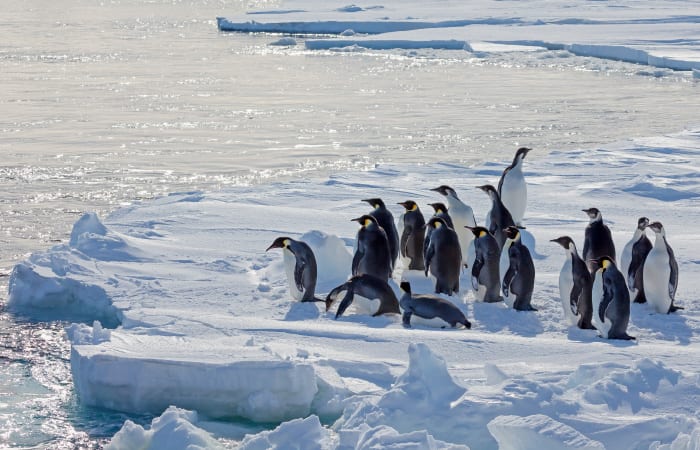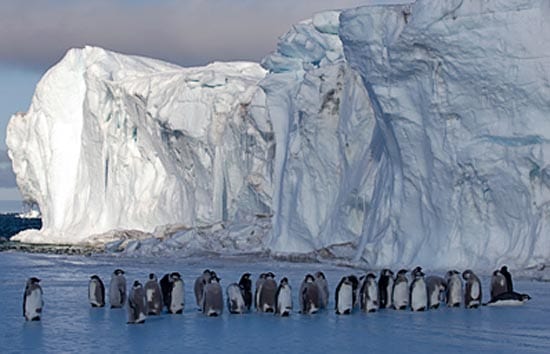Penguins sentinel of climate change
The fragile conservation status of most penguin populations mirrors the Southern Ocean’s condition and the broader challenges facing marine ecosystems worldwide.”
—Global Penguin Society
Facts
- Penguins are flightless marine birds that live almost entirely in the Southern Hemisphere. Highly adapted to aquatic life, they are long-lived species that return to land to breed in dense colonies. Most lay one or two eggs and spend several months raising their chick(s). They dive deep—some over 500 meters—to catch krill, fish, and squid.
- Among penguins, the emperor penguin stands out for its remarkable Antarctic breeding strategy: enduring the harsh winter, males incubate eggs for months on sea ice while females forage at sea (Ainley et al. 2010, Trathan et al. 2020).
- Penguins are extremely sensitive to environmental change. Over 60% of the 18 penguin species are listed as Vulnerable or Endangered by the IUCN. Changes in sea ice, ocean temperatures, and food availability—driven by global environmental variability—threaten their persistence. Even abundant species like the macaroni penguin are declining steeply.
Other websites
Our study
Our research integrates ecology, demography, evolutionary biology, and climate science to better understand how penguin populations respond to environmental change—and to anticipate their future trajectories (Jenouvrier et al. 2009, 2012, 2014, 2020, 2021, 2025, Jenouvrier 2013).
For example, our work contributed directly to the listing of the emperor penguin as a threatened species under the U.S. Endangered Species Act (ESA) (Jenouvrier et al. 2021). By linking long-term biological observations with projections from Earth system models, we demonstrated that environmental change is likely to drive widespread population declines across nearly all colonies by 2100. These findings, submitted to U.S. regulatory agencies, helped provide the scientific basis for the U.S. Fish and Wildlife Service’s 2022 ESA decision—highlighting the importance of forward-looking, evidence-based conservation.
More recently, we applied a novel multi-model ensemble framework—integrating ecological models with climate projections—to assess extinction risk for the emperor penguin under the IUCN Red List criteria (Jenouvrier et al. 2025). Our analysis shows that, without strong mitigation, over 90% of colonies could face extinction risk by the end of the century. Encouragingly, we also find that achieving international climate targets, such as those outlined in the Paris Agreement, could preserve key refuges and stabilize the global population.
This work demonstrates the value of interdisciplinary science for informing conservation decisions in a changing world. As sentinels of ocean health, penguins remind us that timely, science-based action can help protect biodiversity for future generations.
Current and Past Grants Supporting Our Penguin Research
- Morss Institute Colloquia Award: Conservation of Polar Species Endangered by Climate Change
- NASA: Impacts of Growing Antarctic Sea Ice on a Community of Seabirds: Linking Phenology to Population Dynamics
- NSF: Collaborative Research: Phytoplankton Phenology in the Antarctic: Drivers, Patterns, and Implications for the Adélie Penguin
- NSF: Collaborative Research: Polynyas in Coastal Antarctica (PICA): Linking Physical Dynamics to Biological Variability
- NSF: Collaborative Research: A multi-scale approach to understanding spatial and population variability in emperor penguins
- NSF: Collaborative Research: Integrating Antarctic Environmental and Biological Predictability to Obtain Optimal Forecasts
- NASA: Antarctic Marine Predators in a Dynamic Climate
- NASA: Hot Spots in the Ice: Revealing the Importance of Polynyas for Sustaining Antarctic Marine Ecosystems
Related Links
- Articles by Stephanie Jenouvier - The Conversation
- Emperor Penguins on Thin Sea Ice - Frontier
- Emperor Penguins in a Changing World: Unveiling Current Trends and Predicting Future Scenarios - Antarctic Environments Portal
- Emperor Penguin Gets Endangered Species Act Protections - U.S. Fish & Wildlife Service
- Emperor Penguins could march to extinction if nations fail to halt climate change - The Conversation
- As Ice Melts, Emperor Penguins March Toward Extinction - National Geographic
- Pinguino enperadorea desagertarazi liteke nazioek klima-aldaketa geldiaraztea lortzen ez badute
- El pingüino emperador podría marchar hacia la extinción si las naciones no consiguen detener el cambio climático
Related Multimedia
Emperor Penguin colonies around Antarctica (black dots) and sea ice cover.
Penguins: Canaries in the mine of climate warning. (Author: Benoit Leblanc)
Outreach
Oceanus Magazine
From Penguins to Polar Bears
The impacts of climate change in polar regions
from Oceanus magazine August 2014
The Decline and Fall of the Emperor Penguin?
Climate Change and Shrinking Ice Threaten Polar Birds
from Oceanus magazine November 2013



